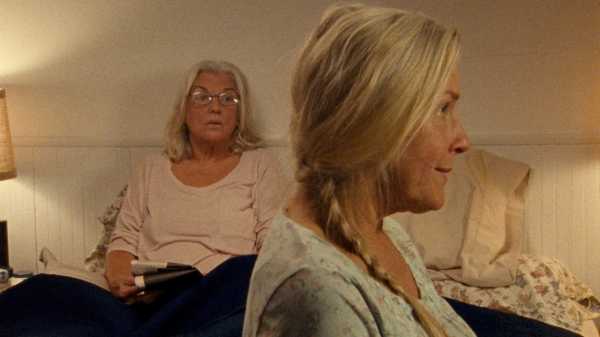
The distinctive premise of Patrick Wang’s new film, “A Bread Factory,” is matched by the audacity and the originality with which he realizes it. This two-part, four-hour film, about the fate of a performing-arts space a small New England town, is a detailed, expansive view of local politics and, for that matter, of the nature of community. It’s set in the fictitious village of Checkford (the movie was actually filmed in Hudson, New York) and centers on one of its most prominent and admired yet embattled residents, Dorothea (Tyne Daly), who, forty years ago, founded that center for the arts in an abandoned bread factory.
The space, called The Bread Factory, is thriving. It shows classic movies and hosts an opera troupe and a theatre company in which Dorothea is a stage director. Her partner, Greta (Elisabeth Henry), is an actress, and they’re currently working on a new production of Euripides’ “Hecuba,” about a woman whose family is destroyed by the wantonly powerful. But their attention is diverted from the play by practical troubles: the local school board is planning to defund The Bread Factory and replace it with a troupe called May Ray, which features two avant-gardish Chinese artists (played by Janet Hsieh and George Young) whose connections to Hollywood and to Chinese-backed institutions promise money, clout, and the sheen of celebrity.
Above all, “A Bread Factory” is a tale of characters, dozens of them, all of whom have their passions and quirks and express themselves vigorously in sharp, insightful dialogue—reverberant aphorisms, dialectical clashes, and florid arias, which are composed by Wang. The subject of the film is the essential moral fibre that is embodied in their every action, that is revealed in each word and gesture, that exerts its influence and replicates its substance in every interactions, however casual. In other words, it’s a story of community, in which Wang, filming a mighty roundelay of encounters and relationships in filigreed detail, displays the deep tissue and secret substance of which a community is made.
Despite the hostility that Dorothea faces from many of the ostensible pillars of the community, she is the town’s virtual mayor, its fixer and energizer. Her company is a beacon of classical artistic culture, from classic to modern. It stages Euripides and Chekhov; it presents opera productions ranging from “La Traviata” to “Lulu” to “Mahagonny”; it hosts a poet (Noah Averbach-Katz) and a filmmaker (Janeane Garofalo), who also teach local students. The artistic lessons that they impart to these children spill over into their family lives, drolly but significantly.
One axis of life in Checkford is the wealth of personal relationships that The Bread Factory has fostered and deepened through decades of common purpose and shared work. Another is the hard practicality of daily life: domestic troubles and financial worries, covert romances and longstanding grudges, petty corruption and differences of culture and principle. These values of artistic humanism, and of money and power—are both mediated by local journalism. When Jan, the editor of the Checkford Journal (played by Glynnis O’Connor), challenges a smarmy consultant, he waxes ironic about her “journalistic integrity.” She responds, “It’s just called integrity, darling, I throw in the journalism for free.”
The community that forms around Dorothea and Greta is inseparable from political activism. The movie begins with an overview of their history of protest against a range of issues, from the expansion of highways to the pollution of the river to the ravages of gentrification. The Bread Factory isn’t just a place of entertainment or education; it’s a place of moral development, a space of warm and frank personal relationships (Greta ultimately defines the theatre as “poor-people therapy”), of collective progress through individual cultivation. The poems recited, the lessons imparted, and the plays produced there display, in stylized form and with a sense of exalted purpose, the conflicts and passions that the residents of Checkford confront. Wang presents the mighty array of characters with an epigrammatic, lightly caricatural flair.The roster of townspeople includes, among many others, the grand, venerable actor Sir Walter (Brian Murray) and a scholarly author and critic (Philip Kerr) with whom he’s feuded for a half-century. There’s a translator (Nana Visitor) whose husband (James Marsters), the head of the teachers’ union, is having an affair with a member of the school board (Nan-Lyn Nelson), who is married to the man who runs the café (Milton Craig Nealy). There’s a waitress (Jessica Pimentel) whom Dorothea and Greta recruit for a role in “Hecuba”; a teen-ager (Zachary Sayle) whom Jan recruits to take over the Journal; the Bread Factory’s precocious and guilt-ridden tween projectionist and artistic factotum (Keaton Nigel Cooke); and a school-board member (Kit Flanagan) who is in mourning for her son, who was devoted to The Bread Factory. There’s also—in the film’s most original performance and its most unusual role—a one-woman chorus of sorts, played by the opera singer Martina Arroyo.
Their action is set in contrast to the flashy and empty pseudo-culture of May Ray, with the duo’s self-aggrandizing, personality-centered, substance-thin performances (which include their own canned applause for the slightest stunt). The mockery extends to a vain young Hollywood star, Trooper Jaymes (Chris Conroy), who comes to town to support May Ray and turns local heads with his fame and his flash. The new arts center is tainted by its association with a range of predatory powers, including corrupt politicians. It is propped up by local residents who see it solely as a wedge for their children’s pre-professional education and who see The Bread Factory as a center of liberal values that differ from their own.
These subtle negotiations build to two grand set pieces. The first is the public hearing on May Ray and the subsequent school-board vote—a scene that plays like a fantasy on themes by Frederick Wiseman. The second is the opening-night performance of “Hecuba,” which, in addition to the mighty artistry that it displays, offers a glimpse of the commercial pressures that the company endures. “A Bread Factory” also takes off in its second half, into the exotic territory of realistic satirical fantasy. A busload of selfie-stick-wielding tourists is pulled into an exuberantly choreographed number complete with a quartet of singing real-estate agents; later, a group of café patrons breaks out in a sudden case of tap-dancing mania. The theatrical fervor that sweeps the town is balanced by the reminiscences, relationships, and stifled anguish that erupt in the performance of “Hecuba.” Yet it’s exemplary of Wang’s vision of local tragedy that the excerpts he depicts, and the themes that are discussed, involve Hecuba’s mourning, not her wrath; her pain, not her vengeance.
It’s in such choices that “A Bread Factory” bumps against its limits. Wang’s vision of high culture can be sentimental, and his view of the relationships he portrays remains somewhat impersonal and lacking in subjectivity. The movie’s calm and wry modesty often stands outside the passions that it parses, and the drama can feel imposed and inorganic, placed on the terrain by Wang. (It stands in contrast, for instance, with another film based on the ideas of place: Kenneth Lonergan’s “Margaret,” whose investigative sense of the politics of institutions and interests seems to emerge, as if from beneath the sidewalk, with the force of the intellectual infrastructure that it dramatizes.) Moreover, for a movie about performance, “A Bread Factory” displays little originality in the style of acting; rather,the very presence of the actors is quietly breathtaking, particularly that of Daly, who, with her wisdom and experience, anchors the movie just as Dorothea anchors the town.
Yet the movie’s limits, however apparent, hardly matter. “A Bread Factory” is, above all, a comprehensive vision: with a ferociously dedicated, deeply empathetic, finely conceived sense of purpose, Wang offers a steadfast utopia of imagination, devotion, integrity, memory, and love in the face of hatred, corruption, despair, and loss. He dramatizes the value of art as the enduring embodiment and living memory of its creators’ humane relationships; he distills community and culture into a mighty cinematic force.
Sourse: newyorker.com






